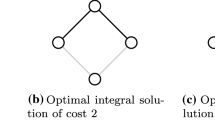Abstract
A telecommunications network is isolated failure immune (IFI) if and only if communication between operative sites can be completed as long as network failures are isolated. It is known that the class of minimal IFI networks is equivalent to the class of spanning 2-trees. To the best of our knowledge, this work is the first computational study dealing with the construction of a minimum cost IFI network. The problem is known to be NP-complete. We develop a tabu search based heuristic for solving the minimum cost spanning 2-tree (MCS2T) problem. The complex structure of 2-trees makes the tabu search heuristic highly dependent on the starting solution. We develop four heuristic algorithms to obtain diversified “good” starting solutions. They are: completion of a 2-tree from a spanning tree, two greedy approaches, and a method based on the recursive definition of a 2-tree. We also formulate an integer programming problem (IP) whose objective function value is a lower bound to the MCS2T problem. We solve the IP by developing a constraint generation scheme. The algorithms were tested on complete random graphs with Euclidean distances and on two real data sets (Civil Aeronautics Board) with instances of 10, 15, 20 and 25 nodes. As a result of this research for “small” problems (10 and 15 nodes), the heuristic solutions are on average within 0.8% from the optimal solution and for “large” problems (20 and 25 nodes), the average error is less than 2.8%.
Similar content being viewed by others
Explore related subjects
Discover the latest articles, news and stories from top researchers in related subjects.References
J.A. Bondy and U.S.R. Murty,Graph Theory with Applications (Macmillan, London, 1976).
L. Cai and F. Maffray, On the spanningk-tree problem, Department of Computer Science, University of Toronto (1992).
A.M. Farley, Networks immune to isolated failures, Networks 11(1981)255–268.
F. Glover, Tabu search — Part I, ORSA J. Comput. 1 (3) (1989) 190–206.
F. Glover, Tabu search — Part II, ORSA J. Comput. 2 (1) (1990) 4–32.
F. Glover and M. Laguna, Tabu search, in:Modern Heuristic Techniques for Combinatorial Problems, ed. C.R. Reeves (Blackwell Scientific Publ., Oxford, 1993).
D. Granot and D. Skorin-Kapov, NC-algorithms for the recognition of partial 2-trees and partial 3-trees, SIAM J. Discr. Math. 4(1991)342–354.
M. Grötschel, C. Monma and M. Stoer, Facets for polyhedra arising in the design of communication networks with low-connectivity constraints, SIAM J. Optim. 2(1992)474–504.
M. Grötschel, C. Monma and M. Stoer, Computational results with a cutting plane algorithm for designing communication networks with low-connectivity constraints, Oper. Res. 40(1992)309–330.
A.S. Fotheringham, A new set of spatial interaction models, The Theory of Competing Destination, Environment and Planning A (1983)15–36.
C.L. Monma and D.F. Shallcross, Methods for designing communications networks with certain two-connected surviviability constraints, Oper. Res. 37(1989)531–541.
D.J. Rose, On simple characterizations ofk-trees, Discr. Math. 7(1974)317–322.
J.A. Wald and C.J. Colbourn, Steiner trees, partial 2-trees and minimum IFI networks, Networks 13(1983)159–167.
Author information
Authors and Affiliations
Rights and permissions
About this article
Cite this article
Beltrán, H.F., Skorin-Kapov, D. On minimum cost isolated failure immune networks. Telecommunication Systems 3, 183–200 (1994). https://doi.org/10.1007/BF02110142
Received:
Accepted:
Issue Date:
DOI: https://doi.org/10.1007/BF02110142




